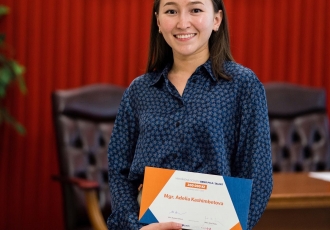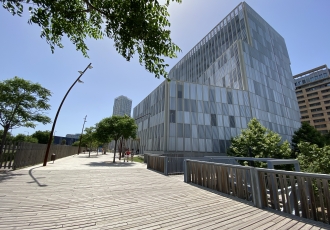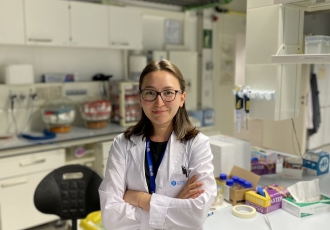11. July 2022
Injury and fracture of the bone – in the best cases only a plaster cast is required, but in the case of a more complicated fracture surgery is necessary. Various materials of natural or synthetic origin are used for bone replacement. One group of implantable materials are calcium phosphate cements (CPCs). When mixed with water, they form a paste that is injectable and able to self-harden after implantation in the bone. The setting of CPCs produces hydroxyapatite, the mineral that bones are made of, and it helps the bone to heal faster. CEITEC BUT scientist Adelia Kashimbetova and her colleagues are pioneers in the processing of CPCs for bone repair and additive manufacturing (3D printing). In doing so, they found out how to prepare hydroxyapatite scaffolds without high temperature heating giving the best mechanical properties. Their findings were published by the prestigious Ceramics International journal.
Success already achieved while studying
Adelia Kashimbetova is student of the Advanced Materials and Nanoscience PhD Programme at CEITEC BUT. She is currently working on biomimetic processing of titanium and hydroxyapatite composites under the supervision of Dr. Edgar Montufar in the Research Group of High-Performance Materials and Coatings for Industry. It is in this unique combination that she sees the future in the field of bone implants. "There are already studies that have investigated composites of titanium and hydroxyapatite, the combination is not new. But the main problem has been the undesirable reaction between these materials when processed at high temperature. Biomedicine would not allow such materials, and we are looking for alternative processing approaches. We take advantage of the fact that the CPCs set and harden by hydrolysis at physiological temperature and shape as we need them to," explains Kashimbetova. Compared to, say, ceramics, which are also used in implants, titanium is tough and won't break. It also has mechanical properties similar to bone. "It's simply the best candidate," Adelia says with a smile, defending her choice of material.
A bone implant made from a composite of titanium and hydroxyapatite can be imagined as a 3D titanium mesh that serves as a skeleton (scientists also use the term scaffold). A paste of calcium phosphate cement is inserted into the gaps. Hydrolysis produces hydroxyapatite crystals that grow through the titanium lattice to form a solid implant. Such an implant is surgically inserted in place of a missing section of bone, such as the femur. The titanium serves as a mechanical support while hydroxyapatite provides multifunctionality in the form of bioactivity, osteoconductivity and osteoinductivity, allowing the bone to heal and rebuild in about 6 weeks. "The advantage of the process is its simplicity. We don't need many difficult steps, people, expensive equipment or extra money to achieve the goal. We produce personalised implants thanks to 3D printing. All we need is actually a paste that hardens in water," generalizes Adelia.
In addition, she won the prestigious Brno Ph.D. Talent competition in 2020 for the subject of her Ph.D. research. Another success for her was the publication of the above mentioned paper. “It was the first time my name appeared on the first page of a study, and in such a high impact journal. It is a huge achievement for me,” she adds. The work behind the publication also allowed Adelia to lead her first own interdisciplinary project between CEITEC and Faculty of Civil Engineering, “the cooperation with the Faculty of Civil Engineering is always fruitful” she said “and I acknowledge BUT for supporting such type of interfaculty cooperation”. Now she has gone to Barcelona for an internship, where she and a group of other students are researching various biomaterials, including titanium and hydroxyapatite. They are also adding metallic ions to titanium for rendering antibacterial properties.
The finer the better
In the published paper, Adelia Kashimbetova and her colleagues focused only on hydroxyapatite. It is formed by hydrolysis of calcium phosphate-based cements (CPCs). Investigations are still underway into how to improve its mechanical, osteoconductive or antibacterial properties, for example. The use of this mineral is attractive because – as was mentioned – it is found in bone. Adelia and colleagues investigated the effect of setting conditions on the mechanical strength of hydroxyapatite. They used different sizes of cement particles – fine, medium and large powder particles. She then allowed them to hydrolyse under different temperature conditions and for different durations. The hydrolysis produced different sizes and shapes of hydroxyapatite crystals. She tested the resulting samples and compared their properties – composition, microstructure, mechanical properties, etc. She found, among other things, that “the smaller the powder, the stronger the hydroxyapatite monolith formed at a lower temperature, thus enabling the complete suppression of heating for processing. The major strength was the result of the formation of a dominant plate-like crystal microstructure, compared to the needle-like microstructure formed when the setting temperature was increased. Our findings have a lot of implications for the processing of bone implants," explains Adelia.
Biomedicine requires the latest and greatest
Even after completing her Ph.D., Adelia Kashimbetova still sees herself researching biomaterials for bone implants. According to her, there will always be something to do as biomedicine always needs something new and better. She says the demand of bone grafts is constantly growing. In addition, it has to respond to current situations such as the ageing population or the increasing incidence of obesity. All this leads to more frequent bone diseases - osteoporosis, etc. "There must always be a solution to help these people. That's why I love this field and would like to continue in it," Adelia Kashimbetova concludes.


 Share
Share




